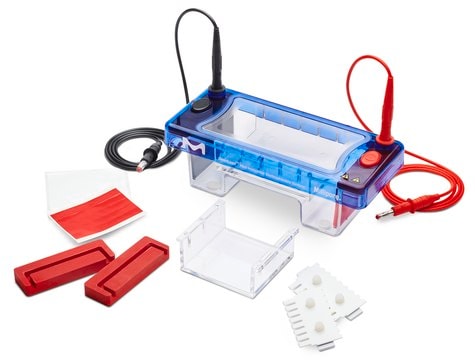RV1MAG-26K
MILLIPLEX® Rat Vascular Injury Magnetic Bead Panel 1 - Toxicity Multiplex Assay
The analytes available for this multiplex kit are: Caveolin-1, CINC-1/GRO/KC, CTGF (Connective Tissue Growth Factor), IL-6, MCP-1, PAI-1 (total), TIMP-1, TNFα, VEGF.
Sinónimos:
Luminex® Rat Vascular Injury Panel, Millipore Rat Vascualr Injury Panel, Rat Vascular Injury Multiplex Assay
About This Item
Productos recomendados
Quality Level
species reactivity
rat
manufacturer/tradename
Milliplex®
assay range
accuracy: 97-108%
intra-assay cv: <10%
standard curve range: 0.1-100 ng/mL
(CINC-1/GRO/KC, IL-6, MCP-1, PAI-1 (total))
standard curve range: 0.1-15 ng/mL
(VEGF)
standard curve range: 0.1-20 ng/mL
(TNFα)
standard curve range: 0.2-150 ng/mL
(TIMP-1)
standard curve range: 0.3-200 ng/mL
(CTGF)
standard curve range: 1.4-1,000 ng/mL
(Caveolin-1)
inter-assay cv: <10%
(All other analytes)
inter-assay cv: <15%
(CINC-1/GRO/KC, PAI-1 (total), TIMP-1, TNFα)
inter-assay cv: <20%
(Caveolin-1)
technique(s)
multiplexing: suitable
detection method
fluorometric (Luminex xMAP)
shipped in
wet ice
General description
The MILLIPLEX® Rat Vascular Injury Bead Panel contains all the components necessary to measure the following 9 biomarkers in any combination using Luminex® xMAP® technology: Caveolin-1, CINC-1/GRO/KC, CTGF (Connective Tissue Growth Factor), IL-6, MCP-1, PAI-1 (total), TIMP-1, TNFα, VEGF. The kit uses a 96-well format, contains a lyophilized standard cocktail, 2 quality controls and can measure up to 38 serum or plasma samples in duplicate.
Panel Type: Toxicity
Specificity
Application
- Analytes: Caveolin-1, CINC-1/GRO/KC, CTGF (Connective Tissue Growth Factor), IL-6, MCP-1, PAI-1 (total), TIMP-1, TNF-α, VEGF
- Recommended Sample type: serum and plasma
- Recommended Sample dilution: 1:4 in kit Serum Matrix
- Assay Run Time: Overnight
- Research Category: Toxicity
Features and Benefits
Packaging
Storage and Stability
Other Notes
Legal Information
Disclaimer
signalword
Danger
Hazard Classifications
Acute Tox. 3 Dermal - Acute Tox. 4 Inhalation - Acute Tox. 4 Oral - Aquatic Chronic 2 - Eye Dam. 1 - Skin Sens. 1 - STOT RE 2
target_organs
Respiratory Tract
Storage Class
6.1C - Combustible acute toxic Cat.3 / toxic compounds or compounds which causing chronic effects
Certificados de análisis (COA)
Busque Certificados de análisis (COA) introduciendo el número de lote del producto. Los números de lote se encuentran en la etiqueta del producto después de las palabras «Lot» o «Batch»
¿Ya tiene este producto?
Encuentre la documentación para los productos que ha comprado recientemente en la Biblioteca de documentos.
Contenido relacionado
MILLIPLEX® toxicity assays advance liver, kidney, and genotoxicity research by simultaneously measuring multiple toxicity biomarkers.
Nuestro equipo de científicos tiene experiencia en todas las áreas de investigación: Ciencias de la vida, Ciencia de los materiales, Síntesis química, Cromatografía, Analítica y muchas otras.
Póngase en contacto con el Servicio técnico










